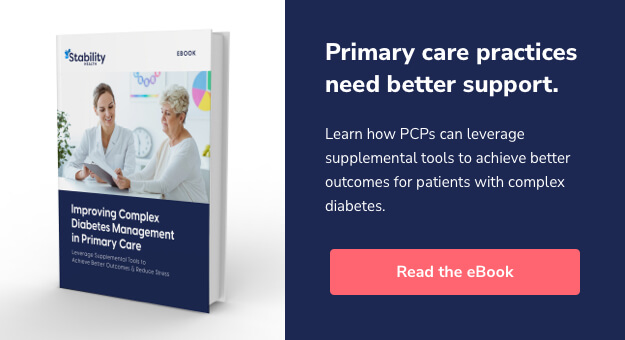![Virtual Diabetes Management Solutions [For Healthcare Providers & Patients]](https://stabilityhealth.com/wp-content/uploads/2021/11/Virtual-Diabetes-Management-Solutions-For-Healthcare-Providers-Patients-1-625x267.jpeg)
Since 1994, the CDC has classified diabetes as an epidemic in the U.S. Each year, at least 83,000 people die of diabetes-related complications and healthcare systems continue to spend $327 billion on diabetes care annually.
A lack of successful clinical outcomes indicates that many of the 34.2 million Americans living with diabetes experience one or more of the following: insufficient clinical care, lack of access to care, and misguided or nonexistent self-management between doctor’s appointments. Endocrinologists who specialize in diabetes are in short supply; because of this, many people with diabetes likely do not live close enough to a specialist to keep regular appointments.
However, with the advent and increasing popularity of virtual healthcare tools, remote diabetes management is gaining traction and helping to mitigate unsuccessful treatment efforts. In many ways, telehealth is ideally suited to chronic disease management, as this typically involves patients building and maintaining daily habits more often than seeking medical intervention.
What is Virtual Diabetes Management?
Diabetes management relies heavily on decisions patients make outside the exam room and, therefore, out of their clinician’s view. Virtual tools, then, can provide valuable support in helping patients sustain successful disease management between medical appointments.
Virtual diabetes management can refer to all or some combination of the following:
- Telehealth appointments with primary care clinicians and/or specialists
- Coaching or guidance from a health expert or diabetes education specialist
- Connection with diabetes management apps or services
- Remote monitoring of health data using digital tools like continuous glucose monitors and cellular meters
- Online or virtual resources that patients can access independently
However patients connect to their remote care, virtual diabetes management tools like those listed above can help close the gaps between in-person appointments or in a PCP’s knowledge of best diabetes treatment practices.
The Importance of Virtual Diabetes Management
Whether a patient lacks access to in-person healthcare or needs more support than their PCP can provide, virtual diabetes management can:
- Provide consistent monitoring of glucose levels
- Support lifestyle modifications, such as diet, sleep, and exercise
- Increase patient engagement with their own care
- Offer depression, anxiety, or general mental health counseling
- Provide preventative programs for patients at risk of developing diabetes
- Reduce patient no-show rates or missed appointments
- Decrease patients’ or caregivers’ time lost from work or other obligations
- Control costs for patients and providers
- Reduce hospital admissions/readmissions or health emergencies
- Provide patients with more control over their disease management
During the height of the COVID-19 pandemic, virtual solutions connected healthcare providers to Americans with routine-to-serious medical needs, many of whom had never experienced virtual healthcare before. For people with chronic illnesses, including diabetes, the consequences of COVID-19 can be substantial; according to the ADA, people with poorly managed diabetes are much more likely to develop serious complications. Now and in the future, it is critical that these patients continue to receive medical care and guidance without jeopardizing their health by exposure to pathogens.
COVID-19 and other public health risks aside, the national shortage of endocrinologists and diabetes specialists jeopardizes many Americans’ access to expert in-person care. The majority of diabetes care is delivered by PCPs with no formal training in diabetes care and, as a patient’s treatment needs become more complex, these general practitioners may over-, under-, or incorrectly prescribe medication. A virtual solution can leverage the expertise of an entire team across geographic locations, including diabetes specialists who can advise a PCP on the best course of action and act as a liaison between the patient and their care team between or during appointments.
Overall access to healthcare becomes even more of a challenge for patients who live in health professional shortage areas (HPSA). HPSAs can affect specific populations or entire geographic areas that lack sufficient access to healthcare providers and/or facilities. Since 81 million Americans live in a HPSA, the likelihood that a patient with diabetes is unable to access quality care increases.
Virtual diabetes solutions can eliminate the obstacle of distance for patients with access to a computer, smartphone, or telephone, especially when it comes to routine check-ups that don’t require physical intervention or tests. Healthcare providers working in HPSAs can reach more patients through virtual means, making more in-person appointments available for critical cases.
Perhaps most important, since most diabetes management happens outside the clinician’s office, virtual support can give a patient more control over their day-to-day responsibilities. Guidance from a remote health coach or access to a location-agnostic expert can make self-management much less overwhelming, which results in overall better health outcomes and more productive clinician-patient interactions.
What Should a Virtual Diabetes Management Program Include?
For a virtual diabetes solution to effectively engage patients, receive the approval of their clinician, and achieve clinically significant results, it should include:
- Expert clinical review and consultation
- Accessibility options for users with a range of technology literacy
- Educational resources for patients, including overviews of Type 1, Type 2, and gestational diabetes, diet and physical activity plans, management of comorbidities, etc.
- A targeted approach to patients with poorly managed or more complicated diabetes cases
- Scheduling flexibility (for consultation with health coaches, patient data logging, etc.)
- The ability to connect patients with digital diabetes tools
- Frequent communication from a dedicated health coach or care team
- Pharmacy support and coordination
- Data security compliance
- Optional: The opportunity for patients to connect with others in the diabetes community for social and emotional support
If the above elements are present, a virtual diabetes tool will likely result in:
- Increased patient engagement and adherence to self-management recommendations
- Lower cost of care for diabetes patients and their providers
- Patients who experience lower A1C, weight loss, and more energy
- Fewer hospital admissions/readmissions and emergencies
While an effective virtual solution should be multifaceted, there are some qualities it should not possess:
- It should not be designed with the intention of replacing the primary clinician or caregiver.
- It should not be purely supplemental and/or exclusive from clinician care; it should be collaborative at all levels.
- It should not seek to provide support without expert guidance and review.
The U.S. Food and Drug Administration (FDA) and European regulating agencies continue to review new virtual healthcare solutions to ensure that these tools prioritize patient safety, security, and medical compliance. As new tools and services appear in the virtual healthcare space, regulations will continue to evolve and change.
Until there is universal standardization for virtual healthcare structure and compliance, patients and their clinicians are advised to partner with solutions — like Stability Health — that are expert-reviewed, accredited, driven by clinical research, collaborative, and proven to deliver real results.



